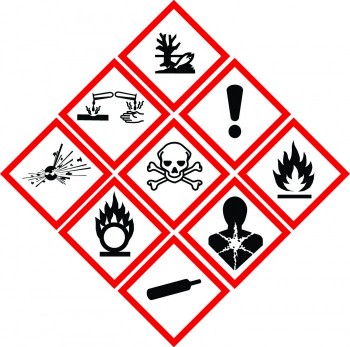What is the CLP Regulation?
All substances and mixtures have to be classified and any hazardous ones have to be labelled and packaged according to the Regulation on classification, labelling and packaging of substances and mixtures (CLP Regulation) before they can be placed on the market. This is important for workers and consumers who are using mixtures such as cleaning products or paints daily. Some of these contain hazardous substances that need to be handled with care and kept away from children.
The CLP Regulation entered into force on 20 January 2009. It aligns the EU legislation with the United Nations’ Globally Harmonised System (GHS). The Regulation replaced two previous pieces of legislation, the Dangerous Substances Directive and the Dangerous Preparations Directive. The internationally agreed classification criteria and labelling helps to protect human health and the environment. The standardised statements and pictograms are useful, for example, when the hazards of chemicals are communicated to workers and consumers using them.
Before placing chemicals on the market, the industry must establish the potential risks to human health and the environment of such substances and mixtures, classifying them in line with the identified hazards. The hazardous chemicals also have to be labelled according to a standardised system so that workers and consumers know about their effects before they handle them.
Thanks to this process, the hazards of chemicals are communicated through standard statements and pictograms on labels and safety data sheets. For example, when a supplier identifies a substance as “acute toxicity category 1 (oral)”, the labelling will include the hazard statement “fatal if swallowed”, the word “Danger” and a pictogram with a skull and crossbones.
When is a classification harmonised?
The most hazardous substances, in particular those that cause respiratory sensitisation, cancer, mutations, or are toxic for reproduction, have a harmonised classification. This is agreed at EU level and is legally binding for all suppliers of that substance.
EU member states, manufacturers, importers and downstream users of substances can propose that a substance has a harmonised classification if they believe it to be hazardous. EU Member States can also propose to revise an existing classification.
A public consultation is organised every time there is a proposal to harmonise the classification of a substance. The consultation lasts for 45 days and anyone, from the EU or other parts of the world, can comment. Comments are received from EU Member States, individual experts, companies and organisations representing industry or civil society.
After the consultation period, ECHA’s Committee for Risk Assessment (RAC) prepares a scientific opinion on the proposal, taking into account the received comments. The opinion has to be adopted within 18 months from the receipt of the proposal. RAC examines the evidence for all hazard classes proposed, and those that were open for commenting during the public consultation. They may also consider another category more appropriate for the classification of the substance after examining the evidence.
ECHA sends RAC’s opinions and any comments received during the public consultation to the European Commission, which decides on the proposal and updates the list of the harmonised classification in Annex VI to the CLP Regulation.
Self-classification
For most substances, the classification is not harmonised. Even when a substance has a harmonised classification, it may not be for all the hazard classes. In these cases, companies need to self-classify their substances and mixtures. It is important to collect all available information, evaluate its reliability and review it against the classification criteria before concluding on the self-classification.
Important sources of information are industry associations and the existing classifications in the C&L Inventory.
CLP – the bigger picture
CLP deals with the majority of the chemicals placed on the industrial, professional and consumer markets in the EU.
More than 20 EU laws refer to classifying and labelling chemicals, meaning that once a substance is classified, other legal requirements kick-in to control their use. These range from the requirement on employers to undertake workplace risk assessment to the possibilities to get an eco-label on a product.
When substances cannot be placed on the market for certain uses because of their classification, companies need to find safer alternatives. For example, substances which are classified as carcinogenic, mutagenic or toxic for reproduction cannot be used in mixtures supplied to consumers above certain concentration levels. A further example is that chemicals with this classification can be added to the Candidate List of substances of very high concern, which means that in the future, an authorisation may be needed for continued use of the substance. A recent example is bisphenol A, which was classified as toxic for reproduction category 1B in July 2016 and which is now proposed for the Candidate List.




